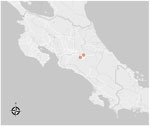Severe Rickettsia typhi Infections, Costa Rica - Volume 29, Number 11—November 2023 - Emerging Infectious ... - CDC
Author affiliations: Instituto Costarricense de Investigación y Enseñanza en Nutrición y Salud, Cartago, Costa Rica (D. Chinchilla, I. Sánchez); Centers for Disease Control and Prevention, Atlanta, Georgia, USA (I. Chung, A.N. Gleaton, C.Y. Kato)
Murine typhus is an acute febrile, fleaborne disease caused by infection with Rickettsia typhi bacteria. The initial symptoms are nonspecific and resemble those of other common bacterial and viral infections. Murine typhus is generally mild to moderate in severity and has a low case-fatality rate, especially in treated patients (1,2). In untreated patients, the case-fatality rate is reported to be 0.4%, and complications can occur in 6%–30% of patients (1).
In Costa Rica, cases of spotted fever group (SFG) rickettsiosis and Rocky Mountain spotted fever have been reported since 1950, and 6 species of Rickettsia have been identified (2,3). In Central America, there is serologic evidence of antibodies in humans against typhus group (TG) Rickettsia in El Salvador, Guatemala, Honduras, Nicaragua, and Panamá, but there are no serologic or molecular reports of R. typhi in Costa Rica (2). We report 2 cases of murine typhus in Costa Rica.
During 2015–January 2021, a total of 190 acute-phase clinical samples from patients suspected of having rickettsiosis, ehrlichiosis, Lyme disease, and other febrile illnesses were submitted to the Centro Nacional de Referencia de Bacteriología, Instituto Costarricense de Investigación y Enseñanza en Nutrición y Salud, Cartago, Costa Rica, for laboratory diagnosis. For rickettsial disease testing, we extracted DNA from whole blood, serum, swab specimens, or biopsy specimens collected <21 days from symptom onset within 3 days of collection by using the QIAamp DNA Mini Kit (QIAGEN, https://www.qiagen.com). We also used automated platforms (Seeprep12 and SGprep 32; Seegene, https://www.seegene.com) for extraction of blood and serum, according to the manufacturer's instructions.
We performed the Rickettsia genus-specific real-time PCR, PanR8, as described (4). We further analyzed all 8 samples that tested positive with the PanR8 assay by using the RRi6 assay; a real-time PCR assay specific for R. rickettsii (causative agent of Rocky Mountain spotted fever) detection (4,5). We assessed amplicon size verification by using gel electrophoresis with the Qiaxcel Automated Platform (QIAGEN). We performed immunofluorescence-IgG (Fuller Laboratories, http://www.fullerlabs.com) when second samples were available.
A total of 104 coded samples were sent to the diagnostics laboratory of the Rickettsial Zoonoses Branch, Division of Vector-Borne Diseases, National Center for Emerging and Zoonotic Infectious Diseases, Centers for Control Disease and Prevention, for diagnostic testing to confirm results by using >1 of the following assays: PanR8 Rickettsia spp. real-time PCR (4), RCKr Rickettsia spp. real-time reverse transcription PCR (6), and RT27 and RT12 for R. typhi (D. Chinchilla, unpub. data). We attempted sequencing for all specimens that had positive results by using the 17kDa (TG and SFG) (7,8) and ompA (SFG) (9,10) gene targets.
We detected Rickettsia spp. nucleic acid in 8 samples (7.7%). Of those, 2 (1 whole blood and 1 serum) were identified as R. typhi (GenBank accession no LS992663.1) by sequencing of the 17-kDa gene targeting TG Rickettsia. The remaining 6 samples that were positive for Rickettsia spp. could not be further identified by sequencing, probably because of low copy numbers (Appendix). The samples corresponding to the 2 murine typhus cases were submitted in March and October 2019.
Both murine typhus patients required hospitalization and had severe disease develop. The patients lived in a rural area in Cartago, a province located in the Central Valley of Costa Rica (Figure). Both patients had fever and moderate symptoms at the early stages but later progressed to severe disease (Table). One of the patients required admission to the intensive care unit and mechanical ventilation, and the other patient died of superimposed nosocomial pneumonia (Table). Neither patient had a rash, which occurs in up to 50% of the patients with murine typhus and is often considered suggestive of rickettsial disease. At hospital admission, both patients had fever of unknown origin, but rickettsiosis was not considered in the clinical diagnosis because of the lack of knowledge of the incidence of rickettsial disease in Costa Rica and the consideration that a rash is expected to occur.
We evaluated samples by using the PanR8 assay as part of the laboratory differential diagnosis assays performed for samples suspected of indicating a tickborne disease. Patient 1 was initially suspected of having leptospirosis or ehrlichiosis, and patient 2 was suspected of having Lyme disease, brucellosis, or dengue; all of those conditions are febrile diseases that have similar symptoms at early stages. Subsequent sequencing using 17-kDa TG primers identified R. typhi DNA within each sample. Patient 2 showed seroconversion to TG in a convalescent-phase sample (titer 1:64)
In conclusion, we report 2 cases of murine typhus in Costa Rica, confirm the presence of R. typhi by sequencing, and document the occurrence of severe disease. Our findings indicate that R. typhi is actively circulating in Costa Rica and is capable of causing severe disease. Early clinical and laboratory diagnosis of SFG and TG rickettsiosis in Costa Rica will ensure timely treatment to prevent complications and deaths. Laboratory confirmation of the specific rickettsial agent is also critical to support epidemiologic interventions, including vector control and community and physician education.
Dr. Chinchilla is a microbiologist in the Laboratory of Febrile Zoonotic Diseases of the National Reference Center of Bacteriology, Cartago, Costa Rica. Her primary research interest is implementation of methods and protocols to improve the diagnosis and epidemiologic surveillance of bacterial zoonoses in the country.
Top
The conclusions, findings, and opinions expressed by authors contributing to this journal do not necessarily reflect the official position of the U.S. Department of Health and Human Services, the Public Health Service, the Centers for Disease Control and Prevention, or the authors' affiliated institutions. Use of trade names is for identification only and does not imply endorsement by any of the groups named above.

Comments
Post a Comment